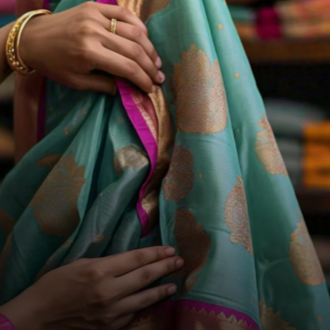
Spotting a Fake: How to Ensure You're Buying Authentic Silk Sarees
Silk sarees are timeless symbols of elegance, tradition, and craftsmanship. Across generations, these sarees have been cherished for their luxurious feel, intricate designs, and cultural significance. However, with the increasing demand for silk, the market has also seen a rise in counterfeit products. Fake silk sarees, often made from synthetic materials like polyester, are passed off as authentic, leaving buyers cheated both financially and emotionally.
Given the emotional and monetary investment in buying a silk saree, especially for significant occasions like weddings and festivals, it is crucial to know how to spot a fake and ensure you're purchasing the real deal. In this guide, we’ll delve into methods for identifying authentic silk sarees, the importance of understanding silk types, and some key statistics to highlight the prevalence of counterfeit silk products.

What Makes a Silk Saree Authentic?
To understand how to spot a fake silk saree, it is first essential to know what sets authentic silk apart. The silk in authentic sarees is typically derived from silk cocoons, with the most popular variety being mulberry silk. Authentic silk has distinct characteristics that cannot be easily replicated by synthetic fibers. Here are the key traits:
- Sheen: Real silk has a soft, subtle shine that changes color when viewed from different angles, thanks to the triangular prism-like structure of the silk fibers.
- Texture: While synthetic fabrics may feel smooth, real silk has a slightly coarse texture when rubbed. It also has a cool touch.
- Weight: Authentic silk sarees, especially heavy types like Kanjivaram sarees, are significantly heavier than their synthetic counterparts due to the density of the silk threads.
Methods to Identify Fake Silk Sarees

There are several tests and techniques you can use to identify whether a silk saree is real or fake. Let's explore these in detail:
1. The Burn Test
One of the oldest and most reliable methods to test the authenticity of silk is the burn test. Although this is not possible in-store, it can be performed at home on a small thread from the saree. Here’s how it works:
- Procedure: Take a small thread from the saree and burn it. Authentic silk, being a natural protein fiber, will burn with the smell of burning hair or feathers and leave a black, crispy residue that can be crushed into powder.
- Fake Silk: Synthetic fibers like polyester will melt and leave behind a hard, plastic-like ball.
Note: This test is destructive and should only be done on a tiny, inconspicuous part of the saree.
2. The Ring Test
The ring test is a simple, non-destructive way to check if a silk saree is real. In this test, you try to pass the entire saree through a small ring (such as a finger ring).
- Authentic Silk: Real silk sarees are usually so fine that they can easily pass through a small ring, especially lighter varieties like Mysore silk.
- Fake Silk: Synthetic sarees, being bulkier and coarser, often struggle to pass through a ring smoothly.
3. The Touch Test
The touch of silk can give away a lot about its authenticity:
- Cool to Touch: Real silk has a natural coolness to the touch, regardless of the surrounding temperature. When held in hand for a few seconds, it slowly warms up.
- Fake Silk: Synthetic fabrics do not have this coolness and can feel plasticky or overly smooth to the touch.
4. Luster Test
The way light reflects on a silk saree can also help differentiate between real and fake silk.
- Authentic Silk: The luster of real silk is soft and changes when viewed from different angles. This is due to the unique triangular prism structure of the silk fibers that refract light.
- Fake Silk: Synthetic sarees, like those made from polyester, have a constant shine that does not change with the angle of light.
5. Water Absorption Test
Silk is known for its ability to absorb moisture. A quick test involves placing a drop of water on the saree:
- Real Silk: The water droplet is absorbed quickly.
- Fake Silk: The droplet remains on the surface or takes longer to be absorbed.
6. Price Check
One of the most obvious indicators is the price. Silk is a luxury fabric, and genuine silk sarees, especially handwoven ones, come with a higher price tag. If a deal seems too good to be true, it probably is.
Common Types of Fake Silk
- Polyester Silk: Often marketed as “art silk,” polyester silk is a common counterfeit material. It has a similar shine to real silk but lacks the texture and durability.
- Nylon Silk: Another synthetic fiber often passed off as silk, nylon silk has a stretchy feel and a bright, overly smooth surface.
- Viscose Silk: While viscose is a semi-synthetic fiber, it is still cheaper than real silk. It lacks the cool touch and luster of authentic silk but can be difficult to differentiate at first glance.
The Importance of Certification
When buying silk sarees, especially expensive varieties like Banarasi or Kanjivaram, always look for certification. The Silk Mark is a certification label by the Silk Mark Organization of India (SMOI) that guarantees the purity of the silk used in the saree. Sarees with the Silk Mark label have been tested for quality and authenticity.
Buying Tips to Avoid Fake Silk Sarees
- Shop at Trusted Retailers: Whether you're buying online or in-store, always shop from trusted retailers or established saree shops. Avoid deals that seem too cheap or unverified online sellers.
- Ask for a Guarantee: When purchasing high-end silk sarees, always ask for a written guarantee or certification of authenticity.
- Inspect the Saree in Person: If possible, visit the store and inspect the saree physically before making a purchase. Look for signs of real silk using the tests mentioned above.
Conclusion
Silk sarees are more than just garments—they are a part of India’s cultural heritage and hold immense sentimental value for many families. However, the growing issue of counterfeit silk sarees means that buyers need to be vigilant and informed. By using simple methods like the burn test, touch test, and checking for certification, you can ensure that you're investing in an authentic silk saree that will stand the test of time. Whether you’re buying a saree for yourself or as a gift, understanding how to spot a fake can help preserve both your money and your love for these timeless garments.
